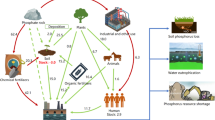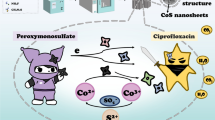Abstract
Phenol biodegradation in a continuous system of immobilized Candida tropicalis NCIM 3556 was studied. The bioreactor was simple, it had a feed inlet from the bottom and the effluent outlet from top, no supplementary oxygen was supplied, the reactor was operated continuously for 116 days. Initially the column was run continuously with a feed concentration of 2 g l−1 for 42 days whence a degradation of >97% was achieved. The feed concentration was then increased to 3 g l−1, for which a ~80% biodegradation was sustained for 90 days after which there was a steady decrease in the performance. When the phenol degradation was reduced to ~50% in 116 days, the reactor was stopped. The efficiency of free cells recycled every 24 h and immobilized cells were compared; it was estimated that repeated reuse of free cells in batch mode gave an overall efficiency of 0.102 g phenol degradation g−1 cell wet weight in 12 days. In contrast, the immobilized system of the same biomass had a longer working lifetime of ~4 months indicating an efficiency of 3.72 g phenol g−1 cell wet wt.



Similar content being viewed by others
References
Acuña-Argüelles ME, Olguin-Lora P, Razo-Flores E (2003) Toxicity and kinetic parameters of the aerobic biodegradation of the phenol and alkylphenols by a mixed culture. Biotechnol Lett 25:559–564
Alemzadeh I, Vossoughi F, Houshmandi M (2002) Phenol biodegradation by rotating biological contactor. Biochem Eng J 11:9–23
Anselmo AM, Mateus M, Cabral JMS, Novais JM (1985) Biodegradation of phenol by immobilized cells of Fusarium flocciferum. Biotechnol Lett 7:889–894
Bandhyopadhyay K, Das D, Bhattacharyya P, Maiti BR (2001) Reaction engineering Studies on biodegradation of phenol by Pseudomonas putida MTCC 1193 immobilized on calcium alginate. Biochem Eng J 8:79–186
Chen KC, Lin YH, Chen WH, Liu YC (2002) Degradation of phenol by PAA—immobilized Candia tropicalis. Enzyme Microb Technol 31:490–497
Chung TP, Tseng HY, Jaung RS (2003) Mass transfer effect and intermediate detection for phenol degradation in immobilized Pseudomonas putida systems. Process Biochem 38:1497–1507
Feitkenhauer H, Schnicke S, Müller R, Märkl H (2003) Kinetic parameters of continuous Cultures of Bacillus thermoleovorans sp A2 degrading phenol at 65°C. J Biotechnol 103:129–135
Godjevargova T, Inanova D, Aleksieva Z, Burdelova G (2006) Biodegradation of phenol by immobilized Trichosporon cutaneum on modified polymer membranes. Process Biochem 41:2342–2346
Karetnikova EA, Shrove AD (2005) Degradation of phenols formed during lignin Pyrolysis by microfungi of genera Trichoderma and Penicillium. Biol Bull 32:445–449
Luke AK, Burton SG (2001) A novel application for Neurospora crassa: progress from batch culture to a membrane bioreactor for bioremediation of phenols. Enzyme Microb Technol 29:348–356
Pazarlioğlu NK, Telefoncu A (2005) Biodegradation of phenol by Pseudomonas putida immobilized on activated pumice particles. Process Biochem 40:1807–1814
Rodenas-Torralba E, Morales-Rubio A, de la Guardia M (2005) Determination of Phenols in waters using micro-pumped multicommutation and spectrophotometric detection: an automated alternative to the standard procedure. Anal Bioanal Chem 383:138–144
Ruiz Ordaz N, Manzano HE, Ruiz Langunez JC, Urbina E, Galindez Mayer J (1998) Growth kinetics model that describes inhibitory and lytic effect of phenol on Candida tropicalis yeast. Biotechnol Prog 14:966–969
Toilova I, Krastanov A, Stanchev V, Daniel D, Gerginova M, Alexieva Z (2006) Biodegradation of high amounts of phenol, catechol, 2,4-dichlorophenol and 2,6-Dimmethoxyphenol by Aspergillus awamori cells. Enzyme Microb Technol 39S:36–41
Tsai SC, Tsai LD, Li YK (2005) An isolated Candida albicans TL3 capable of degrading phenol at large concentration. Biosci Biotechnol Biochem 69:2358–2367
Varma RJ, Gaikwad BG (2008) Rapid and high biodegradation of phenols catalyzed by Candida tropicalis NCIM 3556 cells. Enzyme Microb Technol 43:431–435
Wang Y, Tian Y, Han B, Zhao HB, Bi JN, Cai BL (2007) Biodegradation of phenol by free and immobilized Acinetobacter sp. strain PD12. J Environ Sci 19:222–225
Author information
Authors and Affiliations
Corresponding author
Rights and permissions
About this article
Cite this article
Varma, R.J., Gaikwad, B.G. Continuous phenol biodegradation in a simple packed bed bioreactor of calcium alginate-immobilized Candida tropicalis (NCIM 3556). World J Microbiol Biotechnol 26, 805–809 (2010). https://doi.org/10.1007/s11274-009-0236-7
Received:
Accepted:
Published:
Issue Date:
DOI: https://doi.org/10.1007/s11274-009-0236-7




